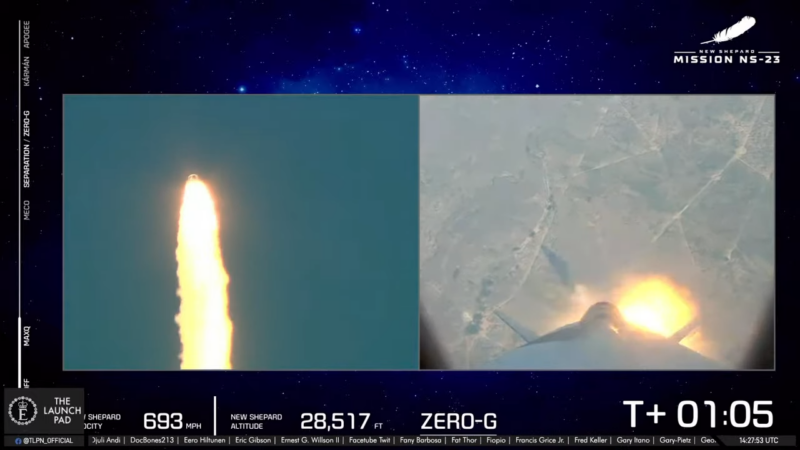
A little more than six months after the failure of its New Shepard rocket, Blue Origin has published a summary of the findings made by its accident investigation team.
For a private company flying a private launch system, the analysis of this "NS-23" mission is reasonably detailed. Essentially, the rocket's main engine nozzle sustained temperatures that were higher than anticipated, leading to an explosion of the rocket.
The accident occurred at 1 minute and 4 seconds into a research flight that launched on September 12, 2022. The emergency escape system performed as intended, rapidly pulling the spacecraft away from the disintegrating rocket. Had a crew been on board this flight, they would have experienced a significant jolt and some high gravitational forces before landing safely in the West Texas desert.
Blue Origin led the investigation, with assistance from the Federal Aviation Administration and the National Transportation Safety Board. Investigators had a wealth of data to pore over, both from telemetry obtained during the flight and hardware recovered from the desert in West Texas.
From this information, the mishap team noted "hot streaks" on the nozzle and determined that it was operating at higher temperatures than it was designed for. Although the summary does not explicitly say so, it appears that at some point in the flight campaign of this booster, design changes were made that allowed for these hotter temperatures to be present.
"Blue Origin is implementing corrective actions, including design changes to the combustion chamber and operating parameters, which have reduced engine nozzle bulk and hot-streak temperatures," the company stated.
The company says it intends to return to flight "soon" with an uncrewed flight to give the three dozen payloads that were flying on the NS-23 mission another shot at weightlessness. Previously, Blue Origin said that it plans to resume human flights on the suborbital space tourism spacecraft later in 2023.
The summary omits some key information. For example, the company has not precisely said what forces the spacecraft experienced during its emergency escape other than to say that humans on board would have survived the experience.
Additionally, it is not clear what rocket will be used to launch the return-to-flight mission. The company's first New Shepard rocket, Booster 1, was lost during an April 2015 flight. Booster 2 was retired in October 2016 after performing a successful test of the launch escape system on its fifth and final flight. Booster 3, which launched the NS-23 mission in September, was the company's oldest operational rocket, making its debut in December 2017.
The company has used its newest rocket, Booster 4, exclusively for human launches. It has some modifications from Booster 3 to qualify it as a human-rated rocket. The company has also built a fifth booster that may be ready for its debut flight. A company spokesperson told Ars that she could offer no information about the next flight beyond what was in the summary.
reader comments
129